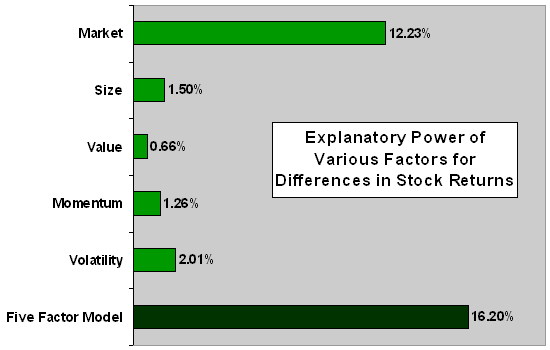Which factors are most predictive of differences in future returns among individual stocks? In their September 2007 paper entitled “Efficient Estimation of a Semiparametric Characteristic- Based Factor Model of Security Returns”, Gregory Connor, Matthias Hagmann and Oliver Linton develop a new method for analyzing the influence of simple fundamental and technical factors on the returns of individual stocks. The method accommodates consideration of additional factors more readily than widely used alternative approaches. Using monthly return data and associated fundamentals for a broad sample of stocks over the period 1962-2005, they find that:
- A five-factor model (market, size, value, momentum, volatility) performs well in comparison to more widely used models.
- The volatility factor (based on standard deviation of monthly returns over the prior 12 months) may be more important than size, value and momentum in explaining differences in returns among individual stocks.
- The relationships between the factors and individual stock returns are all monotonic. However, variations of returns with the size and value factors are decidedly non-linear (dominated by one extreme of the factor ranges), while variations of returns with momentum and volatility are close to linear.
The following figure, constructed from data in the paper, summarizes the explanatory power of each factor separately and all factors together for differences in returns among individual stocks. Specifically:
The Market factor (the degree to which an individual stock’s return varies with the return of the overall market) explains 12.23% of the variation in returns among individual stocks.
The Size effect (based on market capitalization) explains 1.50%.
The Value premium (based on book-to-market ratio) explains 0.66%.
Momentum (based on past returns) explains 1.26%.
Volatility (based on standard deviation of past returns) explains 2.01%.
All five factors used together in a linear model explain 16.20%. Allowing non-linear combination boosts explanatory power to 16.44%.

In summary, a five-factor model effectively explains differences among individual stock returns, with volatility of past returns at least as important as size, value and momentum factors.